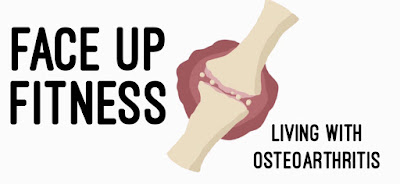Prior to my arthritis diagnosis it never occurred to me that my preferred choice of exercise could be bad for my health. All exercise is good, right? Well, not entirely.
I love weight training and have been doing it regularly for years. Early on in my gym days I never gave much thought to any health risk from the exercise I was doing. I was fit and healthy, as far as I knew, and no exercise was off limits. Then in my 40s I started getting hip pain. Soon after I was diagnosed with congenital hip dysplasia and osteoarthritis. A few things had to change!
My orthopaedic surgeon told me to stop running. High impact training was also a no-no. The weight training though could continue. It is a great exercise for people with osteoarthritis and has undoubtedly delayed the onset of the disease.
Feeling buoyant, I continued weight training without modification. I also started working with personal trainers and was given regular exercise programmes to follow.
Then the injuries started. As the years passed the injuries would become more frequent, the pain more severe and it would take longer for my body to recover. But as soon as I recovered it was back to training, pushing even harder than before, because that's what you are encouraged to do at the gym! Then the penny dropped: some lifts had simply become too much for my arthritic joints.
Osteoarthritis is a degenerative joint disease. As it progresses the lining of a joint, the cartilage, breaks down. The affected joint becomes unstable and the muscles surrounding the joint often weaken. Training with light resistance can help strengthen the weakened muscles and provide the joints with better support, but lifting heavy weights can be problematic.
If you are exercising with incorrect technique or doing more than you can handle, over time these bad habits put unnecessary pressure on the joints, risking injury and further damage. As well as being a cause of osteoarthritis, joint injury when you already have the disease can actually accelerate its progression. So overloading the joints is something you definitely want to avoid!
After my last gym injury in October 2019 something had to change. I decided to row things back and stick to bodyweight, resistance bands and light weight training only. I would build up exercise slowly and introduce one new exercise at a time, to isolate any potential issues.
Rehab this time was tough, and after a year of trying to get back to full fitness with the help of regular physio and a steroid injection to calm inflammation it became clear I was running out of options. During the summer of this year I weighed things up and decided a second steroid injection would be buying, at best, another six months of pain relief. So I chose to have a total hip replacement, something I had always wanted to avoid. My operation is this weekend (NHS waiting times for joint replacement surgery are up to two years so, like many people, I have gone private).
Looking back it's easy to regret some of my past training but regret achieves nothing. It's important to look forward and work with what you have and where you are.
Following the THR I will continue to modify my training. I need to look after my new hip. Replacement joints have an average life expectancy of 15-20 years and revision surgery is often tricky. I am also still dealing with moderate osteoarthritis in my left hip (mild five years ago).
Exercise can really make a positive difference to living with osteoarthritis but be mindful of the exercise you are doing as a poor choice could do more harm than good.




